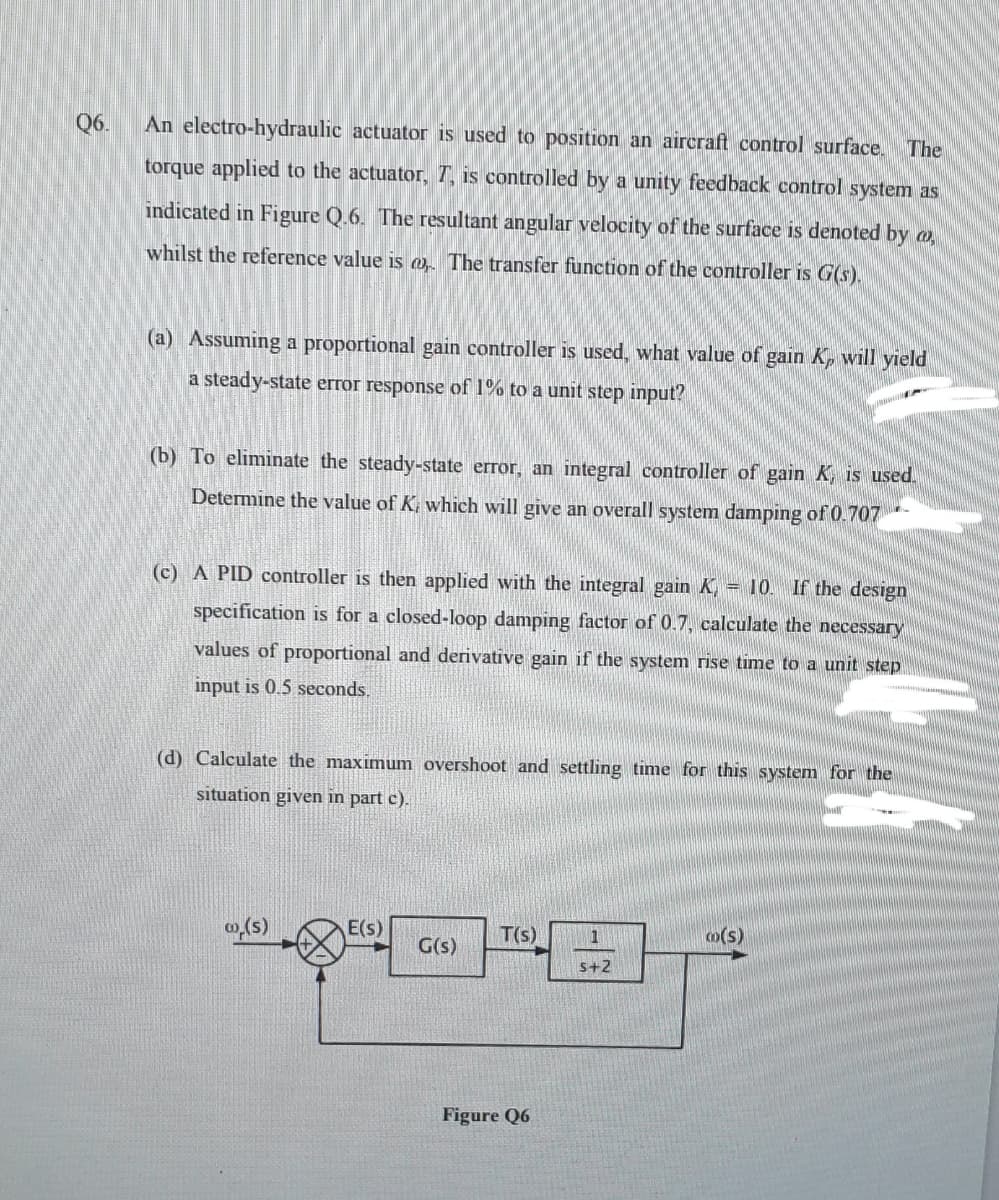Q6. An electro-hydraulic actuator is used to position an aircraft control surface. The torque applied to the actuator, T, is controlled by a unity feedback control system as indicated in Figure Q.6. The resultant angular velocity of the surface is denoted by o, whilst the reference value is m. The transfer function of the controller is G(s). (a) Assuming a proportional gain controller is used, what value of gain K, will yield a steady-state error response of 1% to a unit step input? (b) To eliminate the steady-state error, an integral controller of gain K, is used. Determine the value of K; which will give an overall system damping of 0.707*- (c) A PID controller is then applied with the integral gain K, = 10. If the design specification is for a closed-loop damping factor of 0.7, calculate the necessary values of proportional and derivative gain if the system rise time to a unit step input is 0.5 seconds.
Q6. An electro-hydraulic actuator is used to position an aircraft control surface. The torque applied to the actuator, T, is controlled by a unity feedback control system as indicated in Figure Q.6. The resultant angular velocity of the surface is denoted by o, whilst the reference value is m. The transfer function of the controller is G(s). (a) Assuming a proportional gain controller is used, what value of gain K, will yield a steady-state error response of 1% to a unit step input? (b) To eliminate the steady-state error, an integral controller of gain K, is used. Determine the value of K; which will give an overall system damping of 0.707*- (c) A PID controller is then applied with the integral gain K, = 10. If the design specification is for a closed-loop damping factor of 0.7, calculate the necessary values of proportional and derivative gain if the system rise time to a unit step input is 0.5 seconds.
Power System Analysis and Design (MindTap Course List)
6th Edition
ISBN:9781305632134
Author:J. Duncan Glover, Thomas Overbye, Mulukutla S. Sarma
Publisher:J. Duncan Glover, Thomas Overbye, Mulukutla S. Sarma
Chapter12: Power System Controls
Section: Chapter Questions
Problem 12.3P
Related questions
Question

Transcribed Image Text:Q6.
An electro-hydraulic actuator is used to position an aircraft control surface.
The
torque applied to the actuator, T, is controlled by a unity feedback control system as
indicated in Figure Q.6. The resultant angular velocity of the surface is denoted by a
whilst the reference value is m The transfer function of the controller is G(s).
(a) Assuming a proportional gain controller is used, what value of gain Kp will yield
a steady-state error response of 1% to a unit step input?
(b) To eliminate the steady-state error, an integral controller of gain K, is used.
Determine the value of K, which will give an overall system damping of 0.707-
(c) A PID controller is then applied with the integral gain K, = 10. If the design
specification is for a closed-loop damping factor of 0.7, calculate the necessary
values of proportional and derivative gain if the system rise time to a unit step
input is 0.5 seconds.
(d) Calculate the maximum overshoot and settling time for this system for the
situation given in part c).
E(s)
T(s)
m(s)
1
G(s)
s+2
Figure Q6
Expert Solution
This question has been solved!
Explore an expertly crafted, step-by-step solution for a thorough understanding of key concepts.
This is a popular solution!
Trending now
This is a popular solution!
Step by step
Solved in 4 steps with 4 images

Knowledge Booster
Learn more about
Need a deep-dive on the concept behind this application? Look no further. Learn more about this topic, electrical-engineering and related others by exploring similar questions and additional content below.Recommended textbooks for you

Power System Analysis and Design (MindTap Course …
Electrical Engineering
ISBN:
9781305632134
Author:
J. Duncan Glover, Thomas Overbye, Mulukutla S. Sarma
Publisher:
Cengage Learning

Power System Analysis and Design (MindTap Course …
Electrical Engineering
ISBN:
9781305632134
Author:
J. Duncan Glover, Thomas Overbye, Mulukutla S. Sarma
Publisher:
Cengage Learning